Dell Precision T1600: Workstation Class
by Dustin Sklavos on May 2, 2011 4:55 PM EST- Posted in
- Systems
- IT Computing
- Dell
- Intel
- Xeon
- Precision
- Workstation
- Enterprise
- NVIDIA
Application and Futuremark Performance
Given that the Intel Xeon E3-1270 beating at the heart of our T1600 review unit is essentially a Core i7-2600 with the IGP completely disabled, it's reasonable to expect excellent performance in processor-intensive tasks. Do keep in mind as you look at the PCMark graphs that PCMark05 and Vantage both skew heavily toward SSDs, and the overwhelming majority of systems we've tested thus far have been using some form of SSD. Being a workstation, the CPU is also running at stock clocks, which will also put it at a disadvantage compared to overclocked gaming systems. For now, we don't have many similar systems to compare the T1600 to, but it's clearly a different target market.
UPDATE: After this review went live, Dell expressed concern to us that we were comparing the Precision T1600 to the wrong class of systems and to an extent we agree. The T1600 is our first modern workstation test and we had no other hardware to compare it against, but the majority of these are boutique gaming systems that just aren't going to be suited to the tasks Dell aims the T1600 at. We've pulled the "ultra" gaming suite tests since they were more academic and ultimately of little consequence to the tower's intended market, and added a pricing comparison to give you some idea of how things stack up.

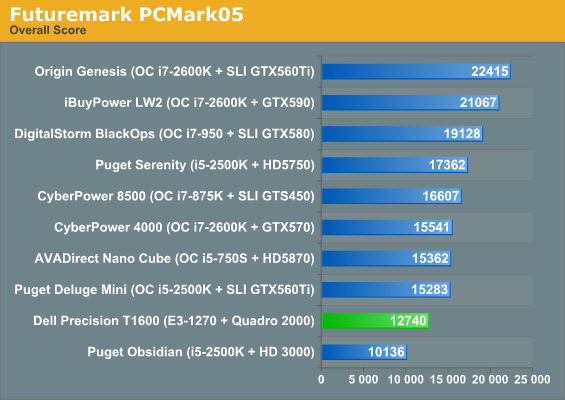
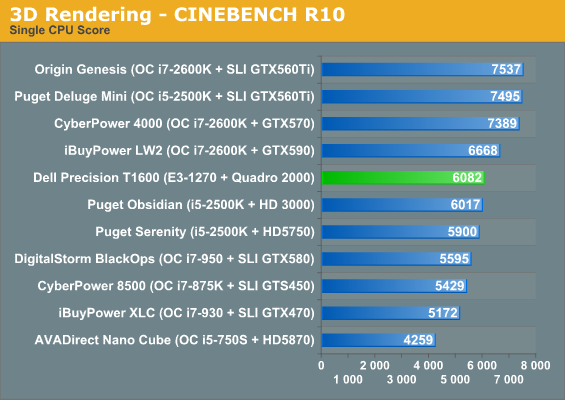
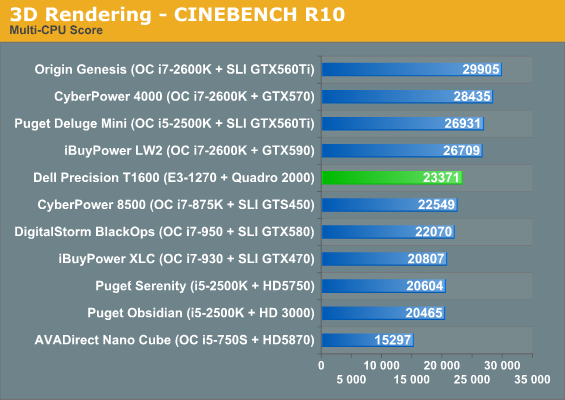
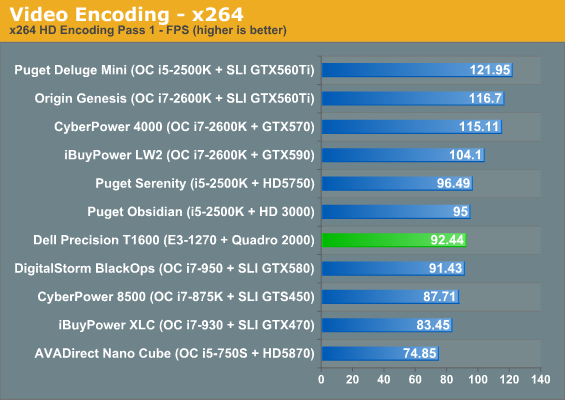
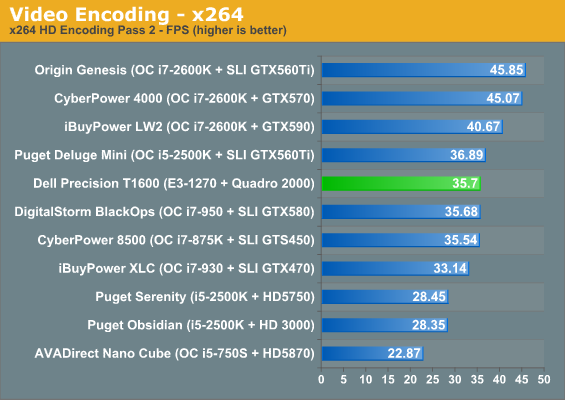
It bears pointing out that generally speaking, the only processors that really given the Xeon E3-1270 any trouble are heavily overclocked (all at least to 4GHz). With a workstation, stability and reliability are king. Overclocking is generally alright for the rest of us, and my own personal desktop has been running an overclocked, undervolted Core i7-930 for close to a year now. But during that period of time, every so often I'd have to retest for stability and boost the voltage a hair, and I know a few of us have seen chips gradually lose their capacity to overclock over time. Having to do that kind of maintenance is something that's simply unacceptable in a business environment.
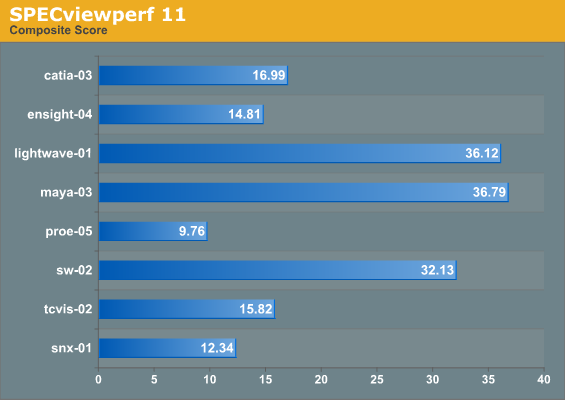
Since this is a workstation, we felt compelled to include testing results from SPECviewperf 11 to give an idea of how the T1600 and by extension the Quadro 2000 performs. To put things in perspective and really help hit home the value of a workstation graphics card, it bears mentioning that the Quadro 2000 produces scores at least two to three times higher than a GeForce GTX 480 would under this test.
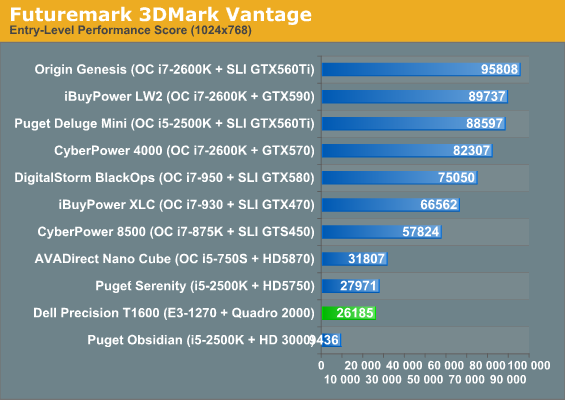

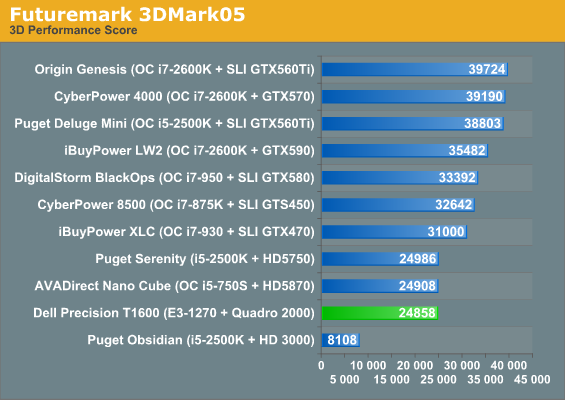
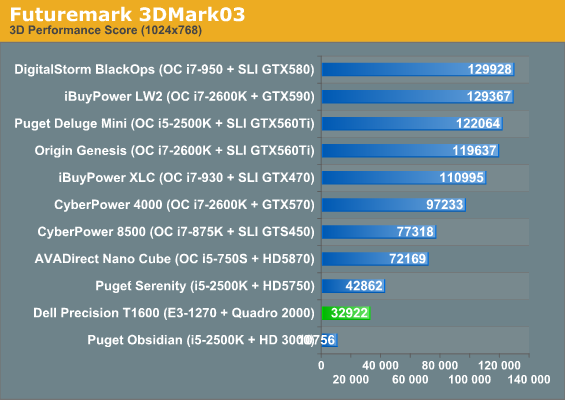
In consumer graphics disciplines, represented here by 3DMark, it should come as no surprise that the GF106-based Quadro 2000 comes in consistently behind the AMD Radeon HD 5750 in the Puget Serenity. Still, it remains miles away from Sandy Bridge's integrated HD 3000 graphics.










29 Comments
View All Comments
Michael REMY - Monday, May 2, 2011 - link
good test but why use old cinebench 10 instead the lastest 11.5 release ?mastard - Monday, May 2, 2011 - link
Why were there no test of workstation type applications? Quadro cards are not optimized or intended for games.JarredWalton - Monday, May 2, 2011 - link
Dustin ran SPECviewperf11; if you have any other specific requests for tests, let him/us know.RandomUsername3245 - Tuesday, May 3, 2011 - link
I'd be interested in seeing tests of pro level graphics cards (Quadro & FireGL) in Solidworks and Autocad.**I'd also be very interested in home-grown benchmarks for these programs (perhaps based on CAD models provided from academia or industry) since we've seen both Nvidia and ATI cheat in past benchmarks for gaming cards.**
Stuka87 - Monday, May 2, 2011 - link
Am I the only one that has never heard of the E3 series Xeon chips? Are they a replacement for the 5600 series, or where do they slot in compared to previous gen Xeons?And yes, Dell RAm is laughably expensive. They wanted $430 to go from 4GB to 8GB in my M4500. I bought 8GB from Crucial instead for $97. They also have crazy prices for SSD's.
It would been nice to see some benchmarks from workstation class applications that make better use of the Quadro.
DigitalFreak - Monday, May 2, 2011 - link
No, they're the replacement for the Xeon 3000 series single socket processors. The 5600 series will be replaced by the E5, but not until Q4 this year.Stuka87 - Monday, May 2, 2011 - link
Oh, and a small typo I believe on page 2 after the specview scores:"Quadro 2000 produces scores at least to three times higher than a GeForce GTX 480 would under this test."
Twirrim - Monday, May 2, 2011 - link
Don't know if it counts for this model range but the 3400 series of workstations are pretty hefty, the heaviest workstations I've ever had the 'pleasure' of lugging around anywhere. They put me in mind of the weight of a decent sized CRT monitor rather than a workstation. That said the build quality is very high on them and the devices do look like they can take a serious beating.smilingcrow - Monday, May 2, 2011 - link
I was surprised how basic the heatsink is on this compared to an Optiplex 980 which is a mere business class desktop and not a workstation. That Optiplex has a much larger heatsink and uses a larger fan so potentially could run even quieter.You didn’t seem to give any actual power consumption figures which would be useful especially at idle. I did read that the P/S efficiency is poor but actual measurements are more useful than just quoting the minimum rated efficiency.
dragonsqrrl - Monday, May 2, 2011 - link
4GB of RAM is a bit low for a system running 64-bit Windows 7, especially considering its intended to run memory hungry workstation applications. Running Maya, Houdini, After Effects, Premier, or even Photoshop, I personally wouldn't go with less then 8GB of memory in a new system. Most of these applications could easily eat up ~3GB of RAM running a single instance with a moderate workload. Hope it's not ridiculously expensive for the 8GB upgrade, it's hit or miss with Dell sometimes.